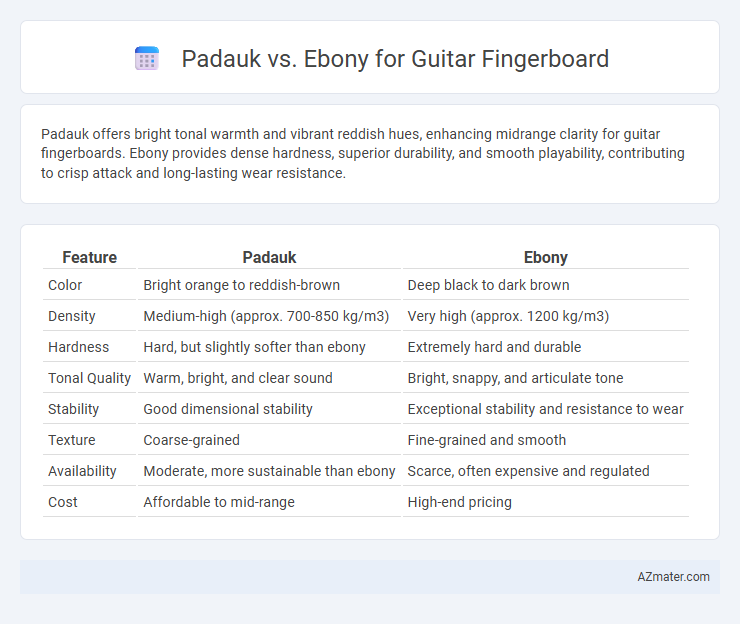Padauk offers bright tonal warmth and vibrant reddish hues, enhancing midrange clarity for guitar fingerboards. Ebony provides dense hardness, superior durability, and smooth playability, contributing to crisp attack and long-lasting wear resistance.
Table of Comparison
| Feature | Padauk | Ebony |
|---|---|---|
| Color | Bright orange to reddish-brown | Deep black to dark brown |
| Density | Medium-high (approx. 700-850 kg/m3) | Very high (approx. 1200 kg/m3) |
| Hardness | Hard, but slightly softer than ebony | Extremely hard and durable |
| Tonal Quality | Warm, bright, and clear sound | Bright, snappy, and articulate tone |
| Stability | Good dimensional stability | Exceptional stability and resistance to wear |
| Texture | Coarse-grained | Fine-grained and smooth |
| Availability | Moderate, more sustainable than ebony | Scarce, often expensive and regulated |
| Cost | Affordable to mid-range | High-end pricing |
Introduction to Padauk and Ebony Fingerboards
Padauk fingerboards are crafted from vibrant reddish-orange hardwood known for its durability and smooth texture, offering a warm tonal quality favored by many guitarists. Ebony fingerboards, renowned for their dense, dark, and fine-grained structure, provide exceptional hardness and a sleek playing surface that enhances sustain and articulation. Both woods serve distinct aesthetic and functional purposes, with Padauk delivering rich mid-range tones and Ebony offering bright clarity and long-lasting performance.
Padauk vs Ebony: Wood Characteristics
Padauk offers a vibrant reddish-orange hue with excellent stability and moderate hardness, making it a lightweight yet durable choice for guitar fingerboards. Ebony features a dense, oily texture with deep black coloration, renowned for its hardness, smoothness, and resistance to wear, providing a very fast playing surface. Both woods deliver distinct tonal qualities, with Padauk offering warmth and brightness, while Ebony emphasizes sharp attack and sustain.
Visual Appeal: Color and Grain Comparison
Padauk fingerboards showcase vibrant reddish-orange hues that deepen over time, offering a striking visual contrast on guitars, while ebony presents a sleek, uniform jet-black to dark brown color prized for its classic, refined look. The grain of Padauk is typically coarse with visible, bold patterns that add a unique, rustic charm, whereas ebony features tight, smooth grain with minimal visible texture, contributing to a polished and elegant aesthetic. Choosing between Padauk and ebony depends on whether the desired guitar fingerboard emphasizes bold, warm coloration and texture or a timeless, sophisticated appearance.
Tone and Sound Qualities
Padauk fingerboards produce a bright, snappy tone with strong midrange presence, enhancing note clarity and attack for articulate playing styles. Ebony offers a dense, smooth surface that delivers a crisp, balanced sound with tight low-end response and clear highs, favored for its sustain and dynamic range. The tonal warmth of Padauk contrasts with Ebony's punchy definition, making each suited to different genres and player preferences based on desired sound characteristics.
Durability and Longevity
Padauk offers excellent durability with a hardness rating of 1600 on the Janka scale, making it highly resistant to wear and dents for guitar fingerboards. Ebony is renowned for its exceptional density and toughness, typically exceeding 3000 on the Janka hardness scale, which ensures superior longevity and minimal fretwear over time. Both woods provide strong resistance to moisture and environmental changes, but ebony's tighter grain structure generally results in a longer-lasting fingerboard surface under heavy playing conditions.
Playability and Feel Under the Fingers
Padauk fingerboards offer a smooth, slightly softer texture that delivers warm tonal qualities and a comfortable grip, enhancing playability for beginners and intermediate players. Ebony, known for its dense, hard surface, provides a slick, fast feel under the fingers, favored by professionals seeking precision and durability. The choice between Padauk and Ebony influences tactile feedback and playing speed, with Padauk yielding a warmer response and Ebony ensuring quicker note transitions.
Maintenance and Care Requirements
Padauk fingerboards require moderate maintenance, benefiting from regular oiling with lemon or mineral oil to prevent dryness and maintain their vibrant reddish hue. Ebony fingerboards demand less frequent oiling due to their dense, oily nature, but occasional conditioning helps maintain their smooth texture and prevents cracking. Both woods appreciate gentle cleaning with a soft cloth and avoid harsh chemicals to preserve their durability and tonal qualities.
Cost and Availability
Padauk offers a more budget-friendly option for guitar fingerboards, typically costing significantly less than ebony while still providing durability and a warm, rich tone. Ebony, known for its dense, smooth surface and premium tonal qualities, commands a higher price due to its slower growth and limited availability, making it rarer and more expensive. The widespread availability of padauk ensures easier sourcing and quicker procurement, whereas ebony's restricted supply often leads to longer wait times and higher costs.
Environmental Impact and Sustainability
Padauk and ebony differ significantly in environmental impact and sustainability for guitar fingerboards. Padauk, a fast-growing tropical hardwood, is often sourced from sustainably managed plantations, resulting in lower deforestation rates compared to ebony, which is typically harvested from slow-growing trees in endangered habitats. Ebony's demand contributes to illegal logging and habitat loss, making padauk a more eco-friendly and sustainable choice for guitar fingerboards.
Choosing the Right Fingerboard: Padauk or Ebony?
Choosing the right guitar fingerboard between Padauk and Ebony involves considering tone, durability, and aesthetics. Padauk offers a bright, warm sound with a distinctive reddish hue that resists moisture and warping, making it ideal for players seeking vibrant tonal clarity and visual uniqueness. Ebony provides a dense, smooth surface with a tight grain, producing sharp, articulate tones and exceptional durability favored by professionals aiming for precision and a classic black appearance.

Infographic: Padauk vs Ebony for Guitar Fingerboard
 azmater.com
azmater.com